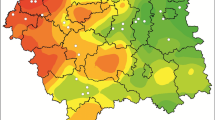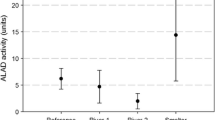Abstract
The concentrations of Pb, Zn, Cd, and fluoride were determined in liver, kidney and femur tissues 30 days after wood mice were provided with water containing soluble salts of these elements in their drinking water. There were eight treatment groups: Pb, Zn, Cd, and fluoride only; Zn and Cd (ZnCd); fluoride and Pb (FPb); fluoride, Pb, Zn, and Cd (FPbZnCd); and a control. Lead concentrations were highest in bone but were also significantly higher in the kidney but not liver when compared to the control. The highest kidney Pb levels were in the FPbZnCd treatment but they were not significantly higher than the Pb only group. Zinc concentrations were highest in kidney and not femur as is usually the case in field caught animals. Cadmium was also highest in the kidney in the high Cd treatments, however, the ZnCd treatment group had significantly lower kidney Cd levels than the Cd only group demonstrating the antagonistic effect of high Zn on Cd accumulation. This effect was reversed when high fluoride and Pb were also present (in the FPbZnCd group) and the kidney Cd reached its highest level. Fluoride showed the typically high levels in bone with only the combined treatment (FPbZnCd) showing a significant increase in kidney fluoride. These results are discussed in terms of the accumulation in wild small mammals caught in polluted sites particularly grasslands established on fluorspar wastes.
Similar content being viewed by others
References
Andrews, S. M., Johnson, M. S., and Cooke, J. A.: 1984a, Environ. Pollut. (Series A) 33, 153.
Andrews, S. M. and Cooke, J. A.: 1984b, in D. Osborn (ed.) Metals in Animals, Institute of Terrestrial Ecology Symposium No. 12 ITE Publications, Monks Wood, Abbotts Ripton, U.K., pp. 11–15.
Andrews, S. M., Johnson, M. S., and Cooke, J. A.: 1989a, Environ. Pollut. 58, 73.
Andrews, S. M., Johnson, M. S., and Cooke, J. A.: 1989b, Environ. Pollut. 59, 241.
Andrews, S. M., Cooke, J. A., and Johnson, M. S.: 1989c, Environ Pollut. 60, 165.
Boyde, C. and Cerklewski, F. L.: 1987, J. Nutr. 117, 2086.
Bremner, I.: 1979, in Webb M. (ed.), The Chemistry, Biochemistry and Biology of Cadmium, Elsevier, North-Holland, pp. 175–190.
Cerklewski, F. L. and Forbes, R. M.: 1976, J. Nair. 106, 689.
Cerklewski, F. L. and Ridlington, J. W.: 1985, J. Nutr. 115, 1162.
Cerklewski, F. L. and Ridlington, J. W.: 1987, Bull. Trace Element Research 14, 105.
Cooke, J. A., Andrews, S. M., and Johnson, M. S.: 1990, Water, Air, and Soil Pollut. (in press).
Cousins, R. J.: 1985, Physiol. Rev. 65, 238.
Davis, N. T.: 1980, Brit. J. Nutr. 43, 189.
Elsair, J., Merad, B., Denine, R., Reggabi, M., Benali, M., Alamir, B., and Ali Rachedi, M.: 1979, Fluoride 12, 136.
Fielder, R. J. and Dale, E. A.: 1983, Cadmium and its Compounds, Toxicity Review No. 7. Health & Safety Executive. HMSO London.
Friel, J. K., Borgman, R. F., and Chandra, R. K.: 1987, Bull. Environ. Contam. Toxicol. 38, 588.
Goyer, R. A. and Mushak, P.: 1977, in Goyer, R. A. and Mehlman M. A. (eds.), Toxicology of Trace Elements, J. Wiley & Sons. New York, pp. 41–77.
Hunter, B. A., Johnson, M. S., and Thompson, D. J.: 1984, in D. Osborn (ed.), Metals in Animals. Institute of Terrestrial Ecology Symposium No. 12. ITE publications, Monks Wood, Abbots Ripton, U. K., pp. 34–44.
Johnson, M. S., Roberts, R. D., Hutton, M., and Inskip, M. J.: 1978, Oikos 30, 153.
Marcus, A. H.: 1982, Environ. Res. 27, 46.
Rao, G. S.: 1984, Ann. Rev. Nutr. 4, 115.
Roberts, R. D., Johnson, M. S., and Hutton, M.: 1978, Environ. Pollut. 15, 61.
Solomons, N. W.: 1982, Am. J. Nutr. 35, 1048.
Standstead, H. H.: 1977, in Goyer, R. A. and Mehlman, M. A. (eds.), Toxicology of Trace Elements, J. Wiley & Sons, New York, pp. 241–256.
Underwood, E. J.: 1977, Trace Elements in Human and Animal Nutrition, 4th ed. Academic Press, New York, pp. 545.
Wright, D. A., Davison, A. W., and Johnson, M. S.: 1978, Environ Pollut. 17, 303.
Author information
Authors and Affiliations
Rights and permissions
About this article
Cite this article
Cooke, J.A., Andrews, S.M. & Johnson, M.S. The accumulation of lead, zinc, cadmium and fluoride in the wood mouse (Apodemus sylvaticus L.). Water Air Soil Pollut 51, 55–63 (1990). https://doi.org/10.1007/BF00211503
Received:
Revised:
Issue Date:
DOI: https://doi.org/10.1007/BF00211503




